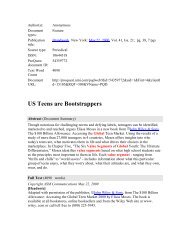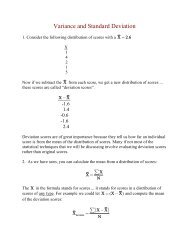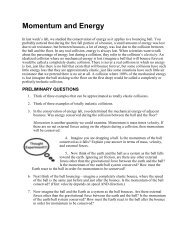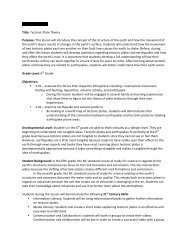Political Cartoons: A Research Note 75 Southwestern Journal of ...
Political Cartoons: A Research Note 75 Southwestern Journal of ...
Political Cartoons: A Research Note 75 Southwestern Journal of ...
You also want an ePaper? Increase the reach of your titles
YUMPU automatically turns print PDFs into web optimized ePapers that Google loves.
<strong>Political</strong> <strong>Cartoons</strong>: A <strong>Research</strong> <strong>Note</strong> <strong>75</strong>POLITICAL CARTOONS: A RESEARCH NOTEDr. Dean A. MinixNorthern Kentucky University"Nixon was to cartooning what Marilyn Monroe was to sex." 1IntroductionStop those damned pictures! Boss Tweed <strong>of</strong> Tammany is said to haveurged his lieutenants after viewing Thomas Nast's cartoon "Who stole thePeople's Money?" explaining "I don't care so much what the papers say aboutme. My constituents can't read. But, damn it, they can see the pictures!" 2As an observer and analyst <strong>of</strong> American and international politics bothvocationally and ad vocationally for the past 30 some years, political cartoonshave always fascinated me. And, I have always said that if I had any artistictalent, I would have been a cartoonist. But, given the fact that I have no artistictalent, and only limited political insight, my career path was pre-ordained--that <strong>of</strong>an academic. Of course, if you look at who draws those damn pictures, you mightthink they were academics. "Put today's cartoonists together in a room and youwill find a sea <strong>of</strong> 200 casually clad white males, their ranks interrupted with onlyan occasional flash <strong>of</strong> skirt or alternate skin tone. Most cheerfully admit to beingsocial misfits in their earlier days: a stutterer, nerd, or general adolescent ne'erdo-wellwho used his or her quick-draw humor to win friends1Doug Marlette, “In Your Face, a Cartoonist at Work,” Houghton-Mifflin, 1991.2Roger Fisher, Those Damned Pictures: Explorations in American Cartoon Art, Archon, 1996, p. 2.<strong>Southwestern</strong> <strong>Journal</strong> <strong>of</strong> International Studies – March 04
<strong>Political</strong> <strong>Cartoons</strong>: A <strong>Research</strong> <strong>Note</strong> 76and gain notoriety." 3 Perhaps cartoonists, like some academics, are like the boywith the brick--just waiting to flail it threw the first plate glass window they find."Good cartoons are like visual rock and roll, writes Newsday cartoonist DougMarlette. "They hit you primitively and emotionally. There is something wild anduntamed about the best <strong>of</strong> them, raw and vaguely threatening like Little Richardor Jerry Lee Lewis…. A cartoon cannot say, 'On the other hand.' And it cannotdefend itself. It is a frontal assault, a slam dunk, a cluster bomb." 4Cartoonists today, like days <strong>of</strong> yore, come from different politicalpersuasions and sociological heritages. Today, however, most cartoonists areliberal democrats, but in the nineteenth century, the opposite was the case.Whatever their perspectives, cartoonists are political lampoonists who produce asubjective view <strong>of</strong> their Weltanschauung. The most important part <strong>of</strong> any cartoonis the idea that drives or motivates it. "Rollin Kirby, one <strong>of</strong> the finest Americannewspaper cartoonists <strong>of</strong> the 20 th century, said that a good cartoon consists <strong>of</strong><strong>75</strong>% idea and 25% drawing. 'A good idea has carried many <strong>of</strong> indifferent drawingto glory,' commented Kirby in 1918, 'but never has a good drawing rescued a badidea from oblivion." 5A cartoonist's job is to attack--to lampoon. They do this through theconvention <strong>of</strong> satire. Cartoonists do not present the daily news. They interpretthe daily news. "As Chicago Tribune cartoonist Jeff MacNelly has said, 'Apolitical cartoon is not like a truckload <strong>of</strong> tomatoes in 90 degree weather. It isn't3Stephen Hess and Sand Northrop, Drawn and Quartered: The History <strong>of</strong> American <strong>Political</strong> <strong>Cartoons</strong>,<strong>Southwestern</strong> <strong>Journal</strong> <strong>of</strong> International Studies – March 04
<strong>Political</strong> <strong>Cartoons</strong>: A <strong>Research</strong> <strong>Note</strong> 77Montgomery: Elliot and Clark, 1996, p. 10.4Ibid., p. 10.5Ibid., p. 11.something that has to be delivered the next day.'" 6 Most good cartoons attack;only the vary rare cartoons applaud something like a peace treaty. It's like WalterCronkite said about the definition <strong>of</strong> news, "it’s news if it's out <strong>of</strong> the ordinary."On an aside, why we consider peace to be the norm, and conflict to be theaberration, I will never understand. Recorded human history does not give thataccounting.In his perceptive analysis <strong>of</strong> Nast's effectiveness in The<strong>Political</strong> Cartoon, Charles Press stressed the shock value <strong>of</strong> rawemotional impact: The Nast cartoon is great because <strong>of</strong> theemotional impact <strong>of</strong> its presentation. It continuously goesbeyond the bounds <strong>of</strong> good taste and conventional manners.Nast is like the man who rings your bell and, when you open thedoor, guns in shouting insults at you and throwing rocks andmud at you and your wife and on your front hall walls. Yourreaction is that what excites him must be a grievous wrong yousomehow unwittingly committed. 7Do cartoons peddle the truth, or are they as fallible as their authors? Well,obviously the answer to this question is indeed one <strong>of</strong> perspective. Where onestands determines what he will see. <strong>Cartoons</strong> are propaganda. But, rememberthe root meaning <strong>of</strong> propaganda is information. The question is informationdecoded by whom and for what purposes. Pat Oliphant, one <strong>of</strong> the mostoutspoken cartoonists in articulating the need to use the cartoon for critical<strong>Southwestern</strong> <strong>Journal</strong> <strong>of</strong> International Studies – March 04
<strong>Political</strong> <strong>Cartoons</strong>: A <strong>Research</strong> <strong>Note</strong> 78comment…states that 'our business is valuable enough to be looked upon as a6Ibid., p. 14.7Fischer, op. cit., p. 14.leading vehicle for printed and savage opinion and someone will always be<strong>of</strong>fended.'" 8"From the little we do know about the psychology <strong>of</strong> political behavior, it islikely that those cartoons most effective as propaganda have tended not toconfront and to challenge but rather to reinforce and build on a priori beliefs,values, and prejudices. Andrew Jackson and William Henry Harrison as frontierfarmer-warriors and Abraham Lincoln as the 'rail-splitter <strong>of</strong> the West' were servedsuperbly by images <strong>of</strong> rustic virtue and primal vigor conforming so well to thepopular mythic ideal <strong>of</strong> the western wilderness, just as John Quincy Adams in1828 and Martin Van Buren in 1840 fell victim to outlandish smear campaigns,mainly because as small, balding men <strong>of</strong> ideas, they epitomized East andEurope. The 1964 LBJ countdown television ads, and Roger Ailes's masterful1968 Nixon media campaign and the1988 Willie Horton spot, become the stuff <strong>of</strong>Madison Avenue legend. They were successful not because they inspired themillions to behold Barry Goldwater, Hubert Humphrey, and Michael Dukakis inalarming new lights, but because they were built upon existing fears thatGoldwater was a reckless war-hawk and the Humphrey and Dukakis were both's<strong>of</strong>t on crime' and pandering to minority ghetto voters." 9<strong>Southwestern</strong> <strong>Journal</strong> <strong>of</strong> International Studies – March 04
<strong>Political</strong> <strong>Cartoons</strong>: A <strong>Research</strong> <strong>Note</strong> 79As Roger Fischer writes,8Ibid., p. 21.By its very nature, political cartoon art in a democratic society hasbeen one <strong>of</strong> the purest artifacts <strong>of</strong> popular culture, seeking toinfluence public opinion through its use <strong>of</strong> widely and instantlyunderstood symbols, slogans, referents, and allusions. The artistmust exploit conventions in fundamental harmony with the 'culturalliteracy' <strong>of</strong> the public or risk almost certain failure, for obscurity andsnob humor are fatal to the medium. Thus the context <strong>of</strong> theeffective editorial cartoon, disregarding altogether its ideology orthe issue at hand, can tell us much about the popular culture <strong>of</strong> itsday. 10The American Industrial Revolution was the watershed event thatpromoted what we now call American popular culture. While early cartoonsreflected a rather traditional cultural heritage with referents to the Bible, themythology <strong>of</strong> Homer, the Renaissance, Shakespeare, etc., the 20 th century sawan erosion <strong>of</strong> these and similar referents for caricature. Today's popular cultureevokes symmetry with television and Hollywood characters. Sports analogies arealso prevalent. Walt Disney and comic books provide good grist.Effective cartooning requires savagery. "Mike Peters once stated,'cartooning is not a fair art. You can never treat anyone justly, adding that mostcartoonists like me--who like to attack--are the loaded guns.' Louisville Courier<strong>Journal</strong> mainstay Hugh Haynie has defined the cartoon as 'an <strong>of</strong>fensive thing'and Bill Mauldin characterized his calling as 'a destructive art,' insisting that theproper function <strong>of</strong> cartoonists is not to act as 'pontificators, or molders <strong>of</strong> thought'<strong>Southwestern</strong> <strong>Journal</strong> <strong>of</strong> International Studies – March 04
<strong>Political</strong> <strong>Cartoons</strong>: A <strong>Research</strong> <strong>Note</strong> 81Gordon W. Allport and Leo Postman, The Psychology <strong>of</strong> Rumor, New York, 1947.10Fischer, op. cit., p. 122.11Fischer, op. cit., p. 16-17.Works ConsultedGordon Allport and Leo Postman, The Psychology <strong>of</strong> Rumor, New York, 1947.Roger Fisher, Those Damned Pictures: Explorations in American Cartoon Art,Archon, 1996.Stephen Hess and Sand Northrop, Drawn and Quartered: The History <strong>of</strong>American <strong>Political</strong> <strong>Cartoons</strong>, Montgomery: Elliot and Clark, 1996.Joe McGinnis, The Selling <strong>of</strong> the President, 1968. New York, 1969.Doug Marlette, In Your Face, a Cartoonist at Work, Houghton-Mifflin, 1991.<strong>Southwestern</strong> <strong>Journal</strong> <strong>of</strong> International Studies – March 04





![Graduate Bulletin [PDF] - MFC home page - Appalachian State ...](https://img.yumpu.com/50706615/1/190x245/graduate-bulletin-pdf-mfc-home-page-appalachian-state-.jpg?quality=85)











